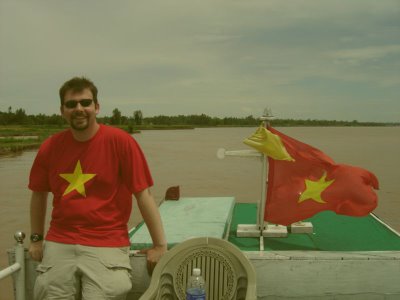The Mighty Mekong
From what we read, it seemed that the preferred method of travel from Ho Chi Minh City (Saigon) and Phnom Penh, the capital and largest city of Cambodia, was to take a boat up the Mekong River. The Mekong has nine separate mouthes which fan out across southern Vietnam, bringing silt-rich water from as far as Tibet, giving that region its tremendous fertility. And it looks like you'd expect: a rich brown color that might not look appealing for swimming or drinking, but makes any rice farmer's mouth water.
 The route we took involved several stretches of bus (not all of the Mekong is navigable) alternating with brief boat trips, gradually edging west and a bit north from HCMC. The delta region is flat, marshy, and intensely farmed. The rice paddies here were not the gorgeous stair-steps of geometrical precision we saw in the Black River Valley, but more plain workaday fields, punctuated only by the elaborate Chinese-style tombs of generations past. The nine mouths of the Mekong frame the delta region, but there are hundreds of smaller channels and canals, like the ones we boated through on our first day, shown here.
The route we took involved several stretches of bus (not all of the Mekong is navigable) alternating with brief boat trips, gradually edging west and a bit north from HCMC. The delta region is flat, marshy, and intensely farmed. The rice paddies here were not the gorgeous stair-steps of geometrical precision we saw in the Black River Valley, but more plain workaday fields, punctuated only by the elaborate Chinese-style tombs of generations past. The nine mouths of the Mekong frame the delta region, but there are hundreds of smaller channels and canals, like the ones we boated through on our first day, shown here.
Beware package deals! Although our ticket into Cambodia was a bargain, we got what we paid for, including a hotel room whose AC unit required the use of my Swiss army knife to get it going. A Texan has a natural, logical response to heat and humidity, and it involves a compressor. My determination to rectify the situation at all costs inspired Amy to snap the following picture.
 The next day was more boat than bus, which made it much more pleasant. We began in these tiny rowboats piloted by middle aged women in intense pajamas (seems to be the uniform of the working class in Vietnam):
The next day was more boat than bus, which made it much more pleasant. We began in these tiny rowboats piloted by middle aged women in intense pajamas (seems to be the uniform of the working class in Vietnam):I was skeptical of this part of the journey, but it proved a wonderfully relaxing start to the day. The marshes were quiet and the morning light soft and warm. We passed many houseboats, most of which have family-run fish farms under their floorboards. We soon reached our main boat (moored near the center of the river) and began the push towards the Cambodian border. Here I am on the deck, demonstrating the accuracy of my Vietnamese flag t-shirt:

There was a marked difference when we crossed the border- what had been a region of many houseboats, rice paddies and rural-but-inhabited land gave way to wide stretches of empty fields and far less intense cultivation. Although we didn't know it at the time, this was just the first signal of Cambodia's many troubles. More on that later.
One great thing about the boat trip was that we met many fellow
 travellers, and the travel scrabble board that we brought along proved an excellent icebreaker, even amongst those who spoke English sparingly. We would run into many of these folks repeatedly over the next week, on buses, in temples and in restaurants. Here's Amy with our pal Jim, an refugee from the IT industry and a Boston native (note the matching hats) who was touring southeast Asia inbetween semesters teaching English in China.
travellers, and the travel scrabble board that we brought along proved an excellent icebreaker, even amongst those who spoke English sparingly. We would run into many of these folks repeatedly over the next week, on buses, in temples and in restaurants. Here's Amy with our pal Jim, an refugee from the IT industry and a Boston native (note the matching hats) who was touring southeast Asia inbetween semesters teaching English in China.Cambodia is the heir to the once-mighty Khmer Empire that ruled all of the region from Vietnam to Thailand almost a thousand years ago. The Khmers are the overwhelming majority ethnic group and thus give their name to the language and culture generally (Khmer cuisine, Khmer custom, and so on), but as with Vietnam and Thailand, many smaller ethnic groups dot the landscape in individual villages and isolated groups, especially the Chams, who account for much of the country's small Muslim population. The Khmer empire reached its zenith in the Angkor period, which gives its name to the archaeological park north of Siem Reap where Amy and I were about to spend three days exploring temples and ruins (more on that coming soon).
Cambodia owes a particular allegiance to Indian culture, to an even greater degree than Thailand, even though Cambodia lies further east. Although Hinduism came to southeast Asia in the eighth century* it found the most fertile ground in what is now Cambodia. Many of the temples of Angkor were commissioned as shrines to Krishna and Shiva, even though many of them were later reconsecrated as Buddhist shrines. Even the form of Theravada Buddhism practiced by the Khmers today has echoes of Hindu thought, particularly about reincarnation.
We made Phnom Penh after nightfall, and found a hotel on the recommendation of our friend Verena. Cambodia is still recovering from its recent history, and services are slim. Thus, large parts of the city are not lit at night (and would be unsafe even if they were), so we were keen to stay near our hotel, and leave exploration for the daylight hours.
Next up: Phnom Penh.


0 Comments:
Post a Comment
<< Home